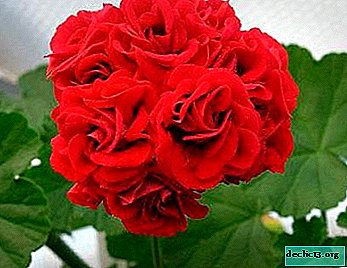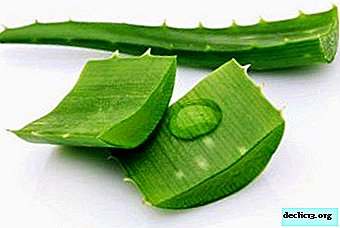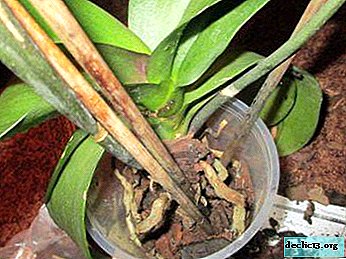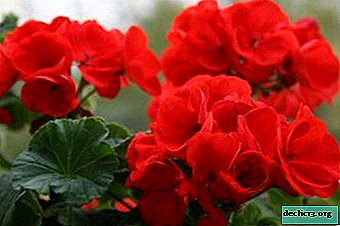An overview of varieties of geranium rosebud, photos, features of home care

Rose geranium is one of the most spectacular representatives of terry hybrids with flowers resembling roses.
This flower is also called rosebud or rosaceous pelargonium. The similarities between these plants and spray roses are incredibly great. Both of them are very beautiful and are popular with flower growers.
In the article, we will not only talk about the different types of rose-bearing geraniums, but also talk about the care, diseases and pests, the rules of cultivation and the features of reproduction.
History and botanical description
Rosaceous geraniums are assigned to the species Pelargonium x hortorum, i.e., garden pelargonium. This species with semi-double flowers appeared at the end of the 19th century in France along with the appearance of pelargonium with double flowers. They came from the spontaneous mutation Pelargonium x hortorum and simple flowers. In shape, their flowers resembled a goblet or cup.
A subgroup of rosebud geraniums is one of the best varieties of Pelargonium x hortorum with double flowers. The first plants arose due to spontaneous mutations in 1850, according to other sources in 1870. And later they became widely known in England in the Victorian era for use as boutonnieres and for creating bouquets.
Speaking about the botanical description of the plant, it should be noted that these are perennial representatives of the flora with branched stems. Their leaves are palmate, flowers are distinguished by a wide variety of colors, gather in multi-flowered umbrella-shaped inflorescences. The fruit is a box with persisting sepals. It is revealed in a special way - from the bottom up.
Appearance
In length, the plant is able to reach 80 cm. Dense large leaves are distinguished by a dark green even color with a light fluff. Particular attention should be paid to the incredible inflorescences of large diameter. They consist of small terry flowers with a large number of petals that form a large ball.
Each bud is like a rose, which is why the name of the variety arose. Flower lovers consider this kind of pelargonium even better than a rose, which is second only to that which does not have a characteristic aroma.Popular varieties and their photos
There are many varieties of rosaceous pelargonium that were bred by breeders and gardeners.
Apple Blossom Rosebud

Apple Blossom Rosebud is believed to be the Queen of England's favorite flower. This is one of the oldest varieties of pink geraniums. Inflorescences are a lot like bouquets of small roses: in the middle, the shade is green-white, alternating with white to the center of the petal, and the edges of the petals are pink. This is a true legend flower.
Tulip-shaped

This is another species of Pelargonium x hortorum, as well as rose geranium. She appeared in Boston thanks to a family of breeders in 1966. Was bred by hybridization. The peculiarity of the variety is that the flowers are collected in bouquets, similar to unblown tulips. These buds never open; they are distinguished by an elongated shape.
Read more about how to care for an unusual tulip-shaped geranium, read here.
Where and how to plant?
This plant will require much more attention than the usual "fingers". Consider what is necessary to ensure for good growth and flowering.
Lighting and location
This plant is considered photophilous, but should not be allowed to be exposed to direct sunlight. For this reason, the stems and leaves begin to fade, turn yellow, and there is not enough water for normal growth.
For this reason, you should choose a place with good lighting, but darken it with special material on the window or with a cloth. So the geranium will have a sufficient amount of light, but there will be no burns that spoil the health and appearance of the beauty. In addition, the plant blooms less from the strong sun.
Attention! But when growing on the street, rosebud geraniums are not afraid of the rays of the sun.Such pelargoniums grow not only indoors, but also in the garden or on the balcony. If you comply with all conditions of detention. It is important to note that all varieties of this variety are sensitive to prolonged low temperatures. It is better if the flowers will not be affected by temperatures below +10.
Soil requirements
Soil for geared geraniums can be purchased in a special store or prepared with your own hands. Land should be purchased with an acidity of 5.6-6.5.
Self-preparation will require a combination of turf land (4 parts), coarse sand (1 part), peat (2 parts), perlite (1 part) and humus (2 parts). In this soil, the plant feels great.
The planting pot should be slightly larger than the root system. In too free, flowering will not occur, but in a close plant it withers.
Care Rules
In addition to choosing the right place and soil, proper care is required to grow geraniums.
Humidity
 This culture is not very demanding on the level of humidity.
This culture is not very demanding on the level of humidity.
If the flower is at home, then to care for it, it’s enough just to ventilate the roomwhere is the pot. On the street, humidity is automatically regulated.
Watering
 Frequent watering is not beneficial. Because of this, it can begin to rot, which will cause its death. For this reason, the soil must be moistened as necessary, and not systemically. To do this, the earth is regularly checked for moisture.
Frequent watering is not beneficial. Because of this, it can begin to rot, which will cause its death. For this reason, the soil must be moistened as necessary, and not systemically. To do this, the earth is regularly checked for moisture.
If fluid is felt, then the bush should not be watered. If the soil is already crumbling, then water is needed.
Attention! Do not use too cold or hot water. It is better that she stood for at least a day indoors.Every week, the plant needs to arrange a bath day. To do this, spray the leaves from the spray gun with settled water. After this, thoroughly wipe the stem and leaves with a soft cloth.
Top dressing
 The plant spends a lot of energy before and during the flowering period. For this reason, special additives and fertilizers are needed. In the spring, mineral lure will do. It is added every 2-3 weeks, for each plant the amount is calculated individually.
The plant spends a lot of energy before and during the flowering period. For this reason, special additives and fertilizers are needed. In the spring, mineral lure will do. It is added every 2-3 weeks, for each plant the amount is calculated individually.
During the setting of buds, phosphorus-potassium compounds must be added. And by the fall, preparations should be gradually excluded so that the plant goes into a dormant period.
Diseases and Pests
- So, if you notice that the leaves began to dry out more and wither, then you should try to increase the amount of water when watering. Another option is to remove the pot from the battery, maybe the air is too dry.
- If the lower leaves turn yellow, then this is evidence of a lack of light.
- When the root system overflows, the plant becomes lethargic, the leaves lose their color.
- If the flowers are actively drying, then there is a chance of a fungus infection. Treatment is carried out with the help of 5% Bordeaux composition. In addition, 2 times with a break of 7 days, Phytosporin treatment is performed.
- Bacterial diseases manifest themselves as geometric brown spots. Transplantation to another land will help, watering should be carried out only in the morning, and the use of fungicides is also necessary. The same method is suitable for a viral infection, but then you should still pay attention to insects. They need to be found and destroyed. To do this, the leaves are sprayed with a solution of aspirin (1.25 tablets per 10 l of water).
- Rust on the leaves, a manifestation of gray spots and white fluff, brown parts of the stems - speak of a fungus. It is destroyed by special means - fungicides. Next you need to re-sow the soil in order to clean from the rotted parts, to exclude nitrogen fertilizers, to remove rotting places of the plant.
Propagation Features
 This plant is quite tender, therefore it can show whims during reproduction. You can propagate by cuttings and seed method, but when using the latter, the plant does not inherit the quality of the parent bush.
This plant is quite tender, therefore it can show whims during reproduction. You can propagate by cuttings and seed method, but when using the latter, the plant does not inherit the quality of the parent bush.
Cutting rose geranium can be in any season. But the best time is March-July:
- From the main plant should be cut half lignified stalk with 3-5 internodes. Grassy green does not take root.
- The land is suitable only for shops, as she is disinfected. Vermiculite is also needed.
- In transparent plastic glasses, pour a mixture of vermiculite and earth 1: 1.
- Put prepared cuttings in it. The preparation is simple - you need to cut the stalk, remove the leaves as much as possible (only the primordium of the leaf is left). The slice is slightly dried (30-40 minutes in air).
The key to good rooting is cleanliness and fresh land. In the early days, the handle is very carefully watered - you can not dry it or pour it. The plant takes root 2-3 weeks under the lamp. After the appearance of the first roots, you can add fertile soil.
Agricultural cultivation
Agrotechnics growing geraniums is quite simple. You must comply with all of the above rules. In the process of growth, the plant needs periodic complex feeding, proper lighting without excessive amounts of direct sunlight.
Water needs the most ordinary, but it should be defended and warmed to room temperature.
Conclusion
Today, thanks to the work of breeders, a lot of varieties of rose-shaped geraniums have been created. Ivy hybrids are also included in this group. These are hybrid plants of the ivy and zonal geraniums, whose stems are somewhat shorter, and their flowers are larger than in other rose-bearing varieties. Such a plant is great for garden and home.

















